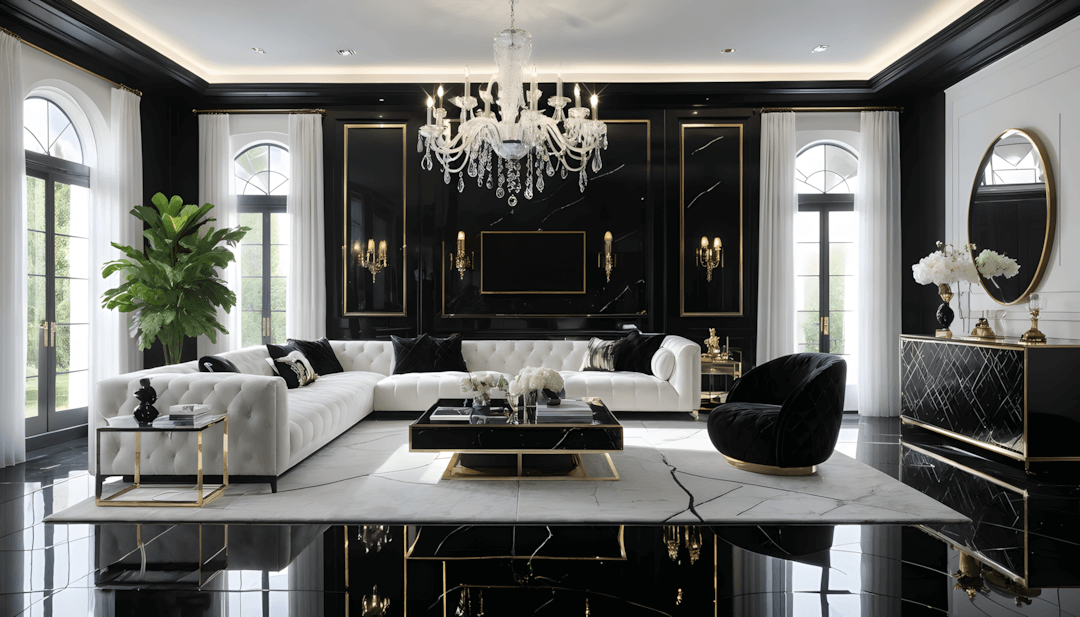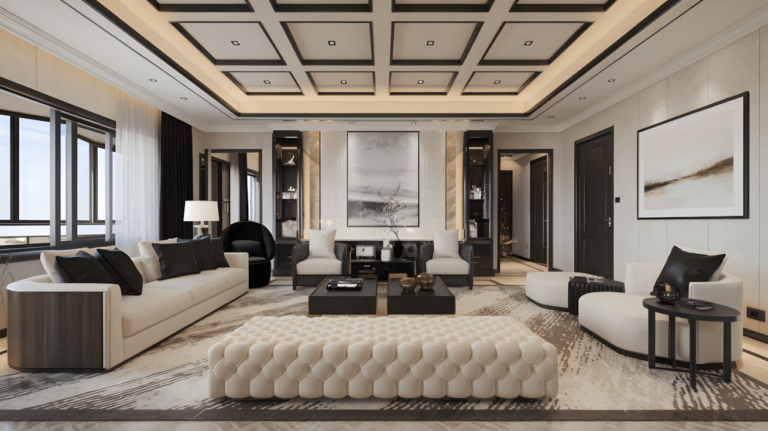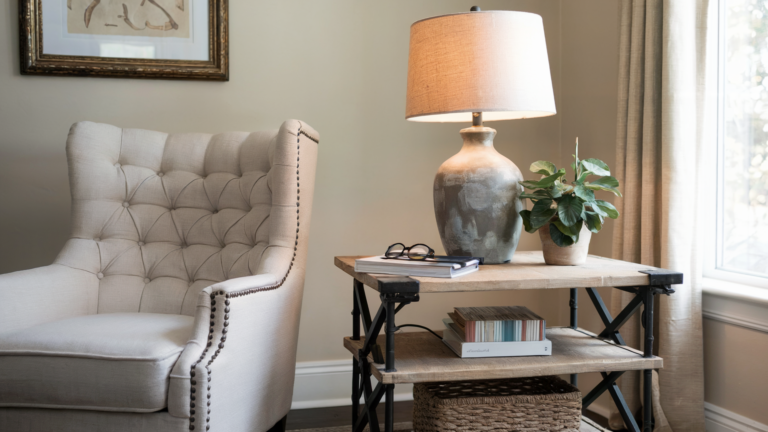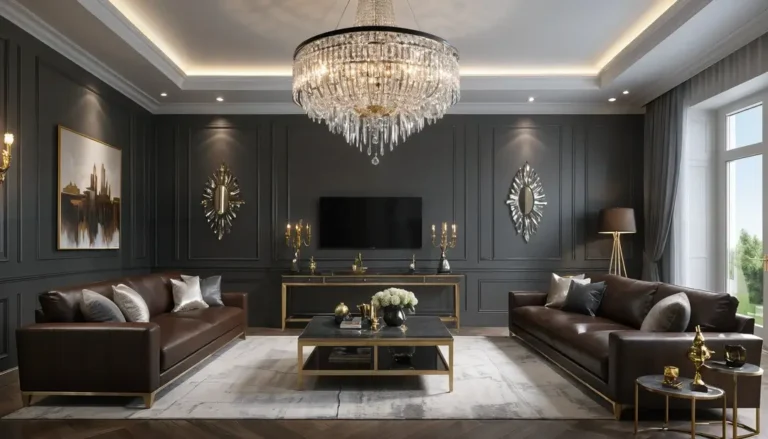In my experience working with homeowners on living room designs, I’ve observed that black and white color schemes often serve as sophisticated foundations that provide both visual impact and design flexibility.
Through various projects, I’ve learned that this classic combination typically works well because it creates striking contrast while remaining neutral enough to accommodate different furniture styles and personal preferences.
Note: For any structural modifications, electrical work, or installations mentioned in this article, always consult with licensed professionals to ensure safety and code compliance.
What makes black and white living rooms particularly effective is their ability to create dramatic visual interest without relying on complex color coordination. I’ve found that homeowners often choose this approach because it typically provides timeless appeal while allowing for easy updates through accessories, textures, and lighting changes.
The key to successful black and white design often lies in balancing the stark contrast with varied textures, proper lighting, and strategic use of different finishes. Effective monochrome spaces typically consider proportion, scale, and visual weight distribution while creating environments that feel both sophisticated and livable.
Here are 29 black and white living room approaches that often work well in different home environments, based on observations from various design projects.
1. Sophisticated Monochrome Foundation
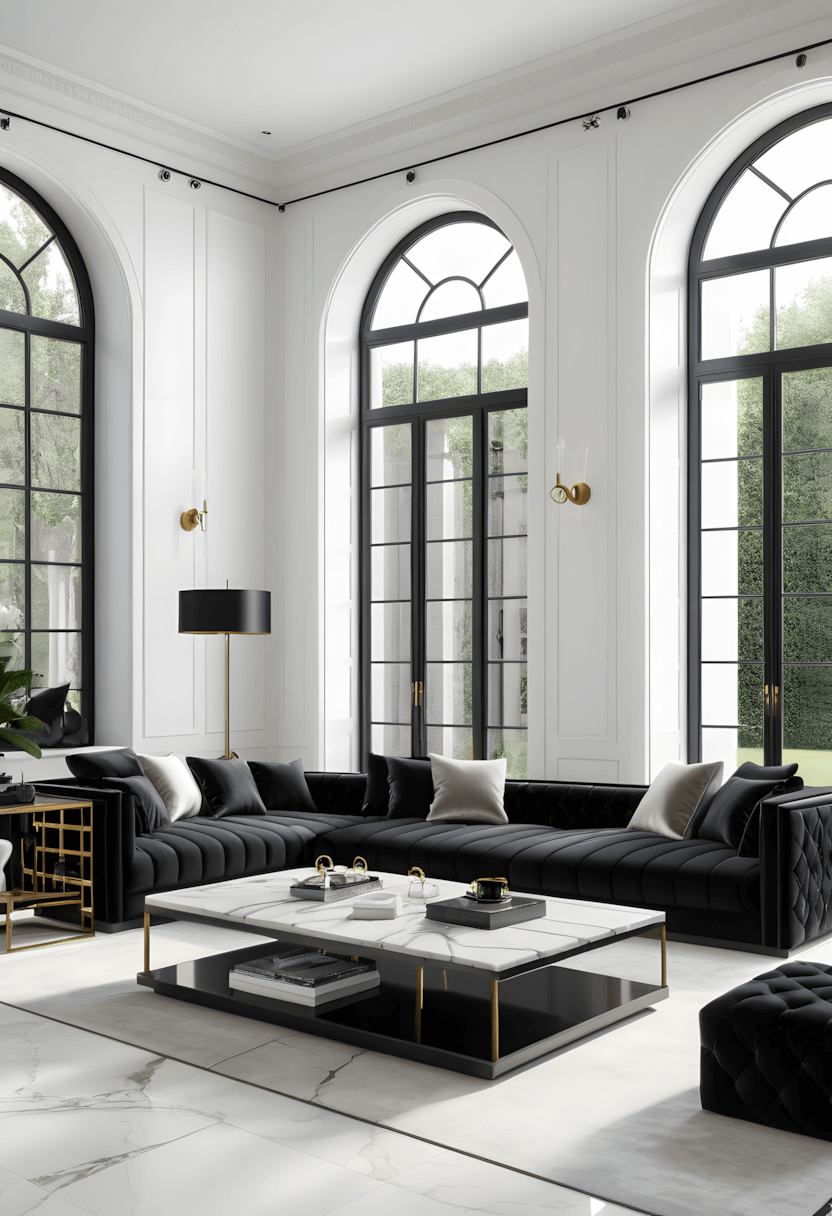
This elegant approach often appeals to homeowners seeking refined, luxurious environments. Black furniture paired with white walls typically creates sophisticated contrast while providing foundations for quality accent pieces.
Design consideration: Marble, velvet, or other luxury materials often enhance the monochrome base while adding textural interest and visual richness.
Lighting strategy: Layered lighting often becomes crucial for showcasing the contrast and preventing stark black-and-white schemes from feeling harsh.
2. Clean Minimalist Approach
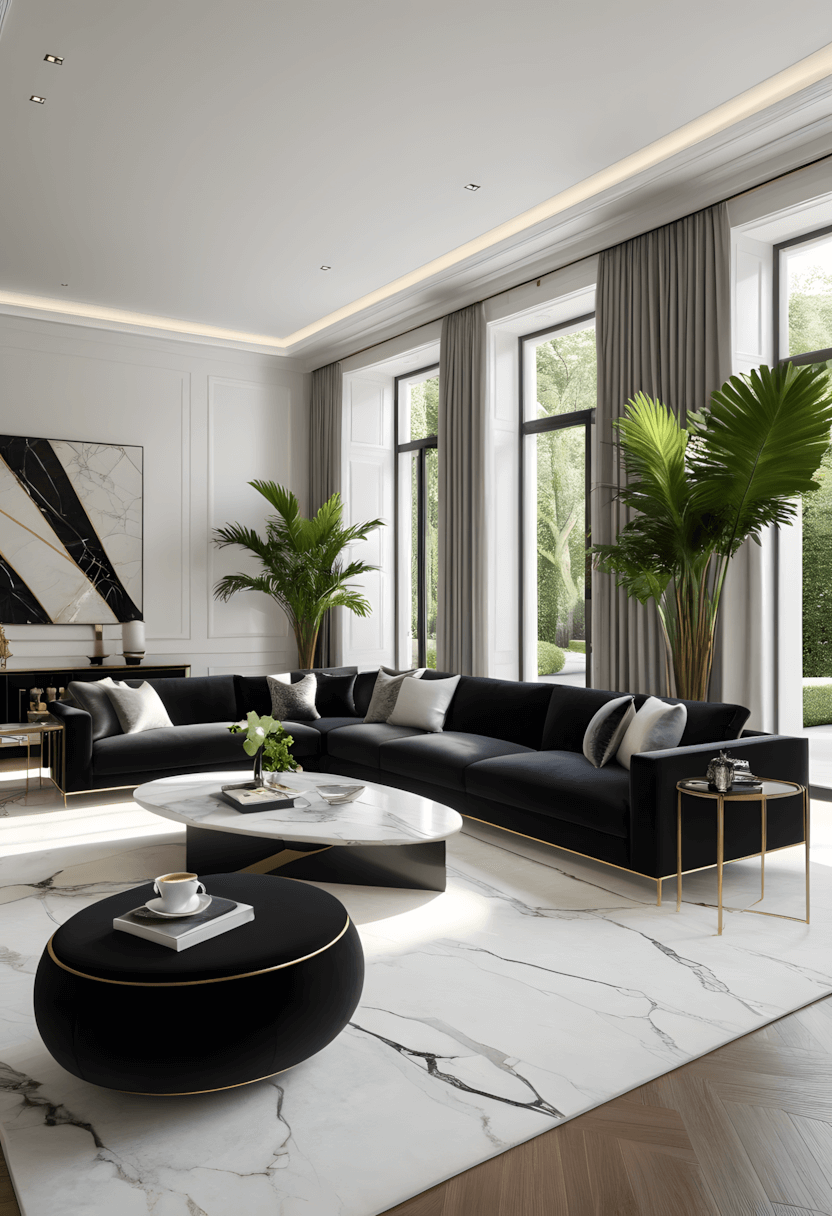
This streamlined style often works well for homeowners appreciating simplicity and order. Minimal furniture in black and white typically creates calm, uncluttered environments that emphasize quality over quantity.
Design principle: Open space and clean lines often allow each piece to make meaningful impact while maintaining the serene minimalist aesthetic.
Practical benefit: This approach often requires less maintenance and decorating decisions while remaining visually sophisticated.
3. High-Contrast Drama
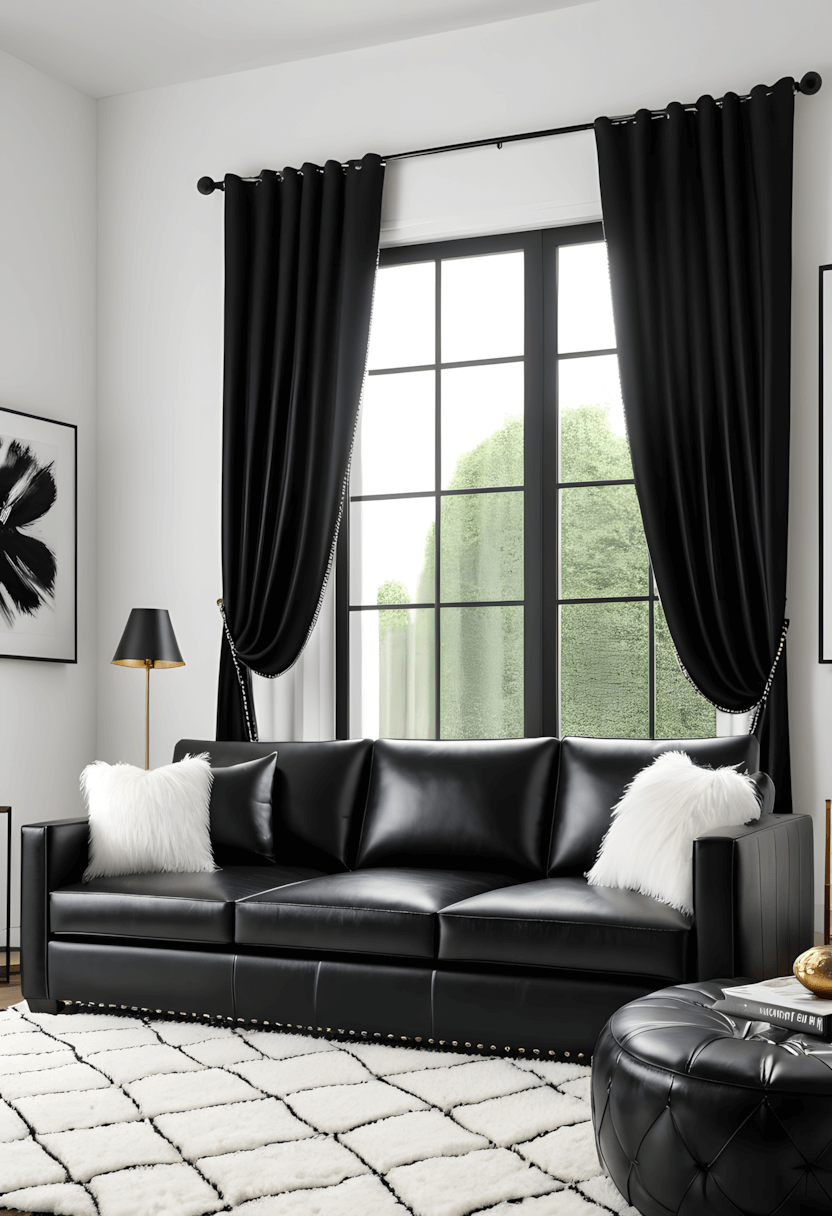
This bold approach often appeals to homeowners wanting striking visual impact. Strong contrasts between black and white elements typically create dynamic, attention-grabbing environments.
Design balance: Gray accents often help bridge the stark contrast while maintaining the dramatic effect without overwhelming the space.
Style consideration: This approach often works best in rooms with adequate natural light to prevent the contrast from feeling too harsh.
4. Geometric Pattern Integration
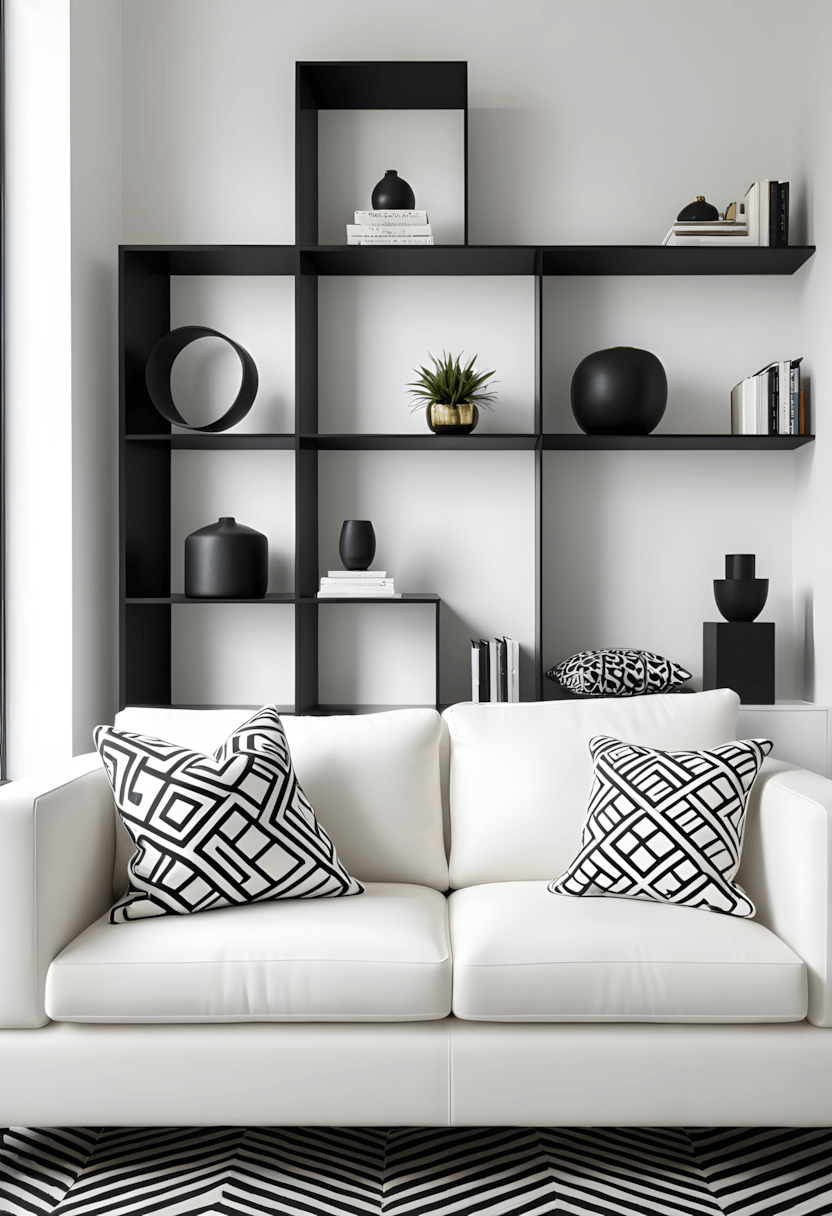
This structured approach often works well for homeowners appreciating order and visual rhythm. Geometric elements in black and white typically create organized, mathematically pleasing environments.
Design application: Geometric shelving, patterned pillows, or structured furniture arrangements often provide visual interest while maintaining the monochrome theme.
Balance strategy: Mixing different geometric scales often prevents patterns from appearing monotonous or overwhelming.
5. Refined Simplicity

This understated approach often appeals to homeowners preferring elegant restraint. Simple forms in black and white typically create sophisticated environments that feel both polished and approachable.
Material focus: Quality materials and perfect proportions often become more important when relying on simple forms and limited colors.
Design philosophy: This approach often demonstrates that sophistication comes from thoughtful selection rather than complex decoration.
6. Contemporary Cleanliness
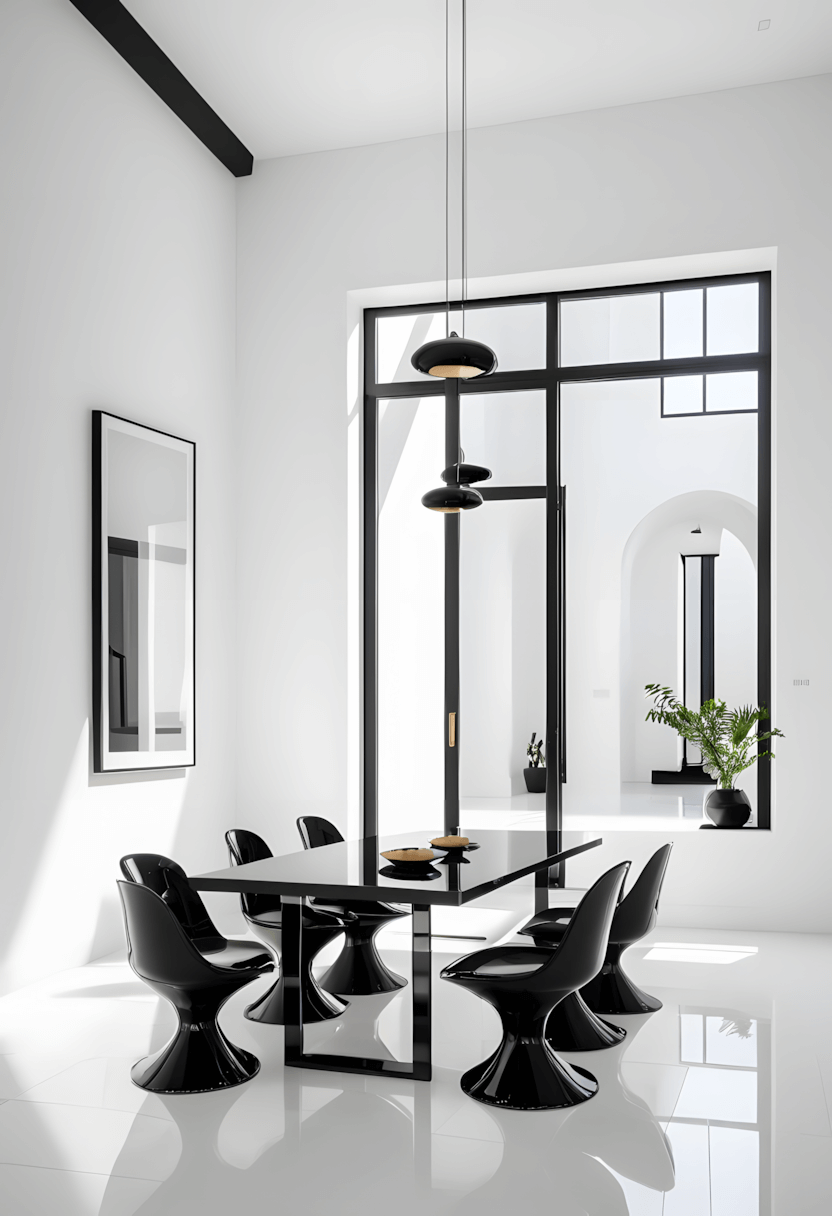
This modern approach often works well for homeowners wanting fresh, current aesthetics. Contemporary furniture in black and white typically creates environments that feel both timeless and of-the-moment.
Texture variety: Matte and glossy finishes often work together to create subtle interest while maintaining the clean contemporary appeal.
Space enhancement: This approach often makes rooms feel larger and more open through its emphasis on clean lines and uncluttered surfaces.
7. Urban Elegance
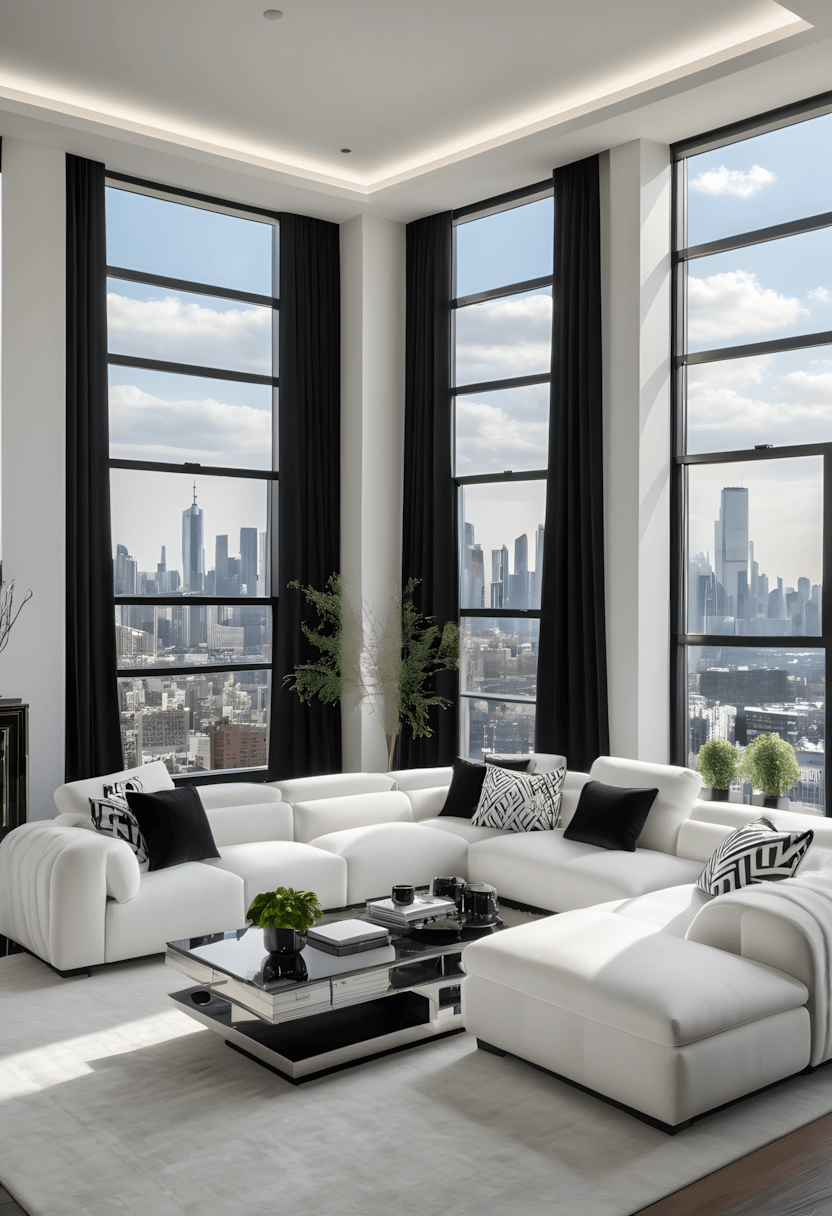
This cosmopolitan approach often appeals to homeowners wanting sophisticated city-style living. Black and white elements with metallic accents typically create environments that feel upscale and current.
Design elements: High ceilings, large windows, and quality materials often enhance the urban sophistication while maintaining livability.
Accent strategy: Silver, chrome, or glass elements often complement the monochrome base while adding contemporary luxury touches.
8. Classic Timelessness
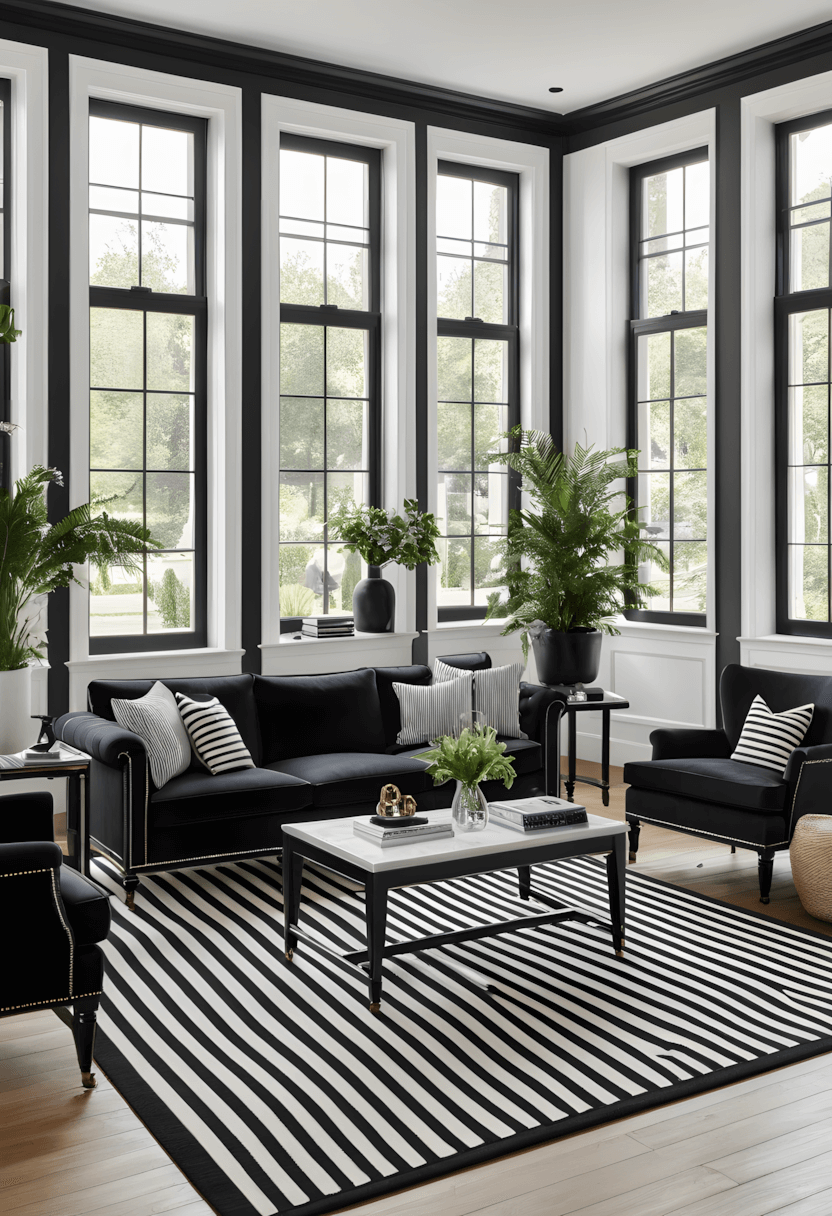
This enduring approach often works well for homeowners appreciating traditional elegance with modern appeal. Classic furniture styles in black and white typically create environments that transcend trends.
Design longevity: This approach often provides lasting appeal because it relies on fundamental design principles rather than current fashion.
Accessory flexibility: Classic foundations often accommodate changing accessories and seasonal updates without requiring major revisions.
9. Bold Graphic Impact
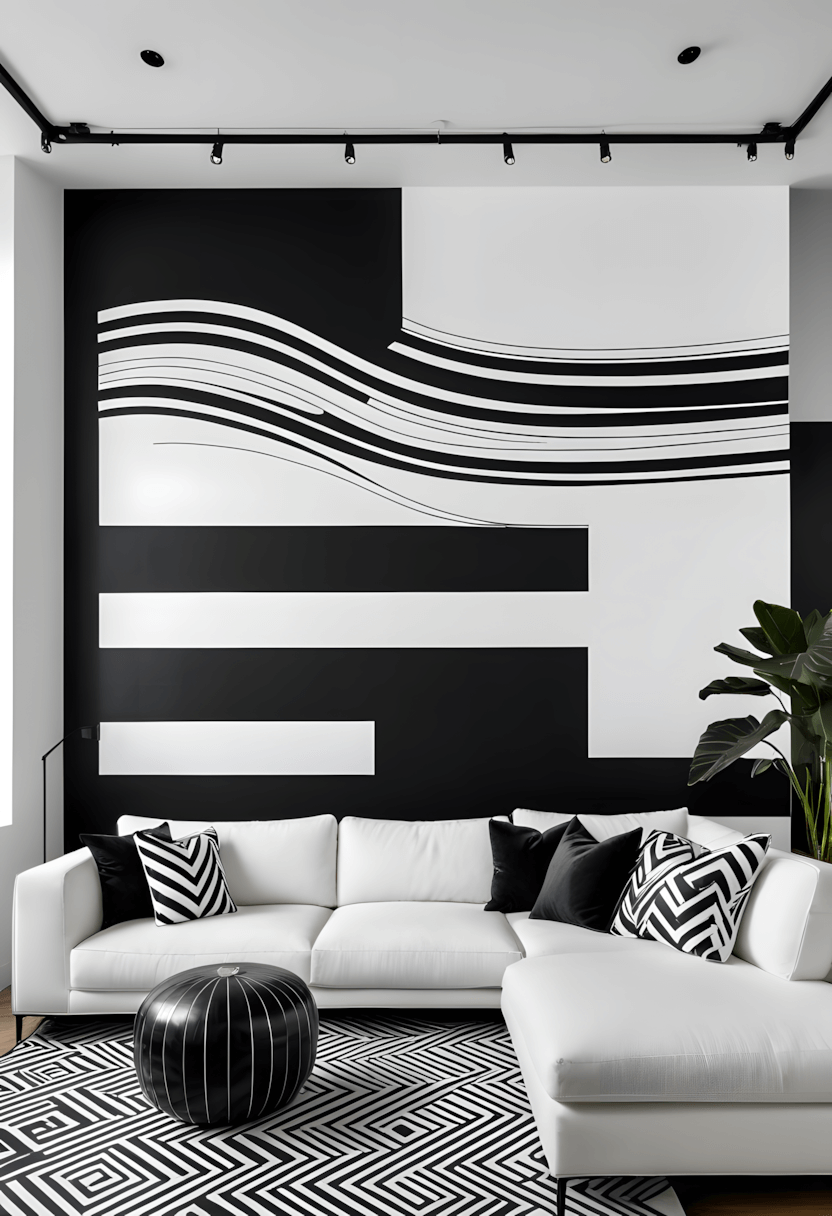
This artistic approach often appeals to homeowners wanting statement-making design elements. Large-scale graphics or bold patterns typically create focal points while maintaining monochrome sophistication.
Scale consideration: Oversized art or dramatic patterns often work best when balanced with simpler surrounding elements.
Personal expression: This approach often allows for individual creativity while maintaining the sophisticated black-and-white foundation.
10. Luxurious Minimalism
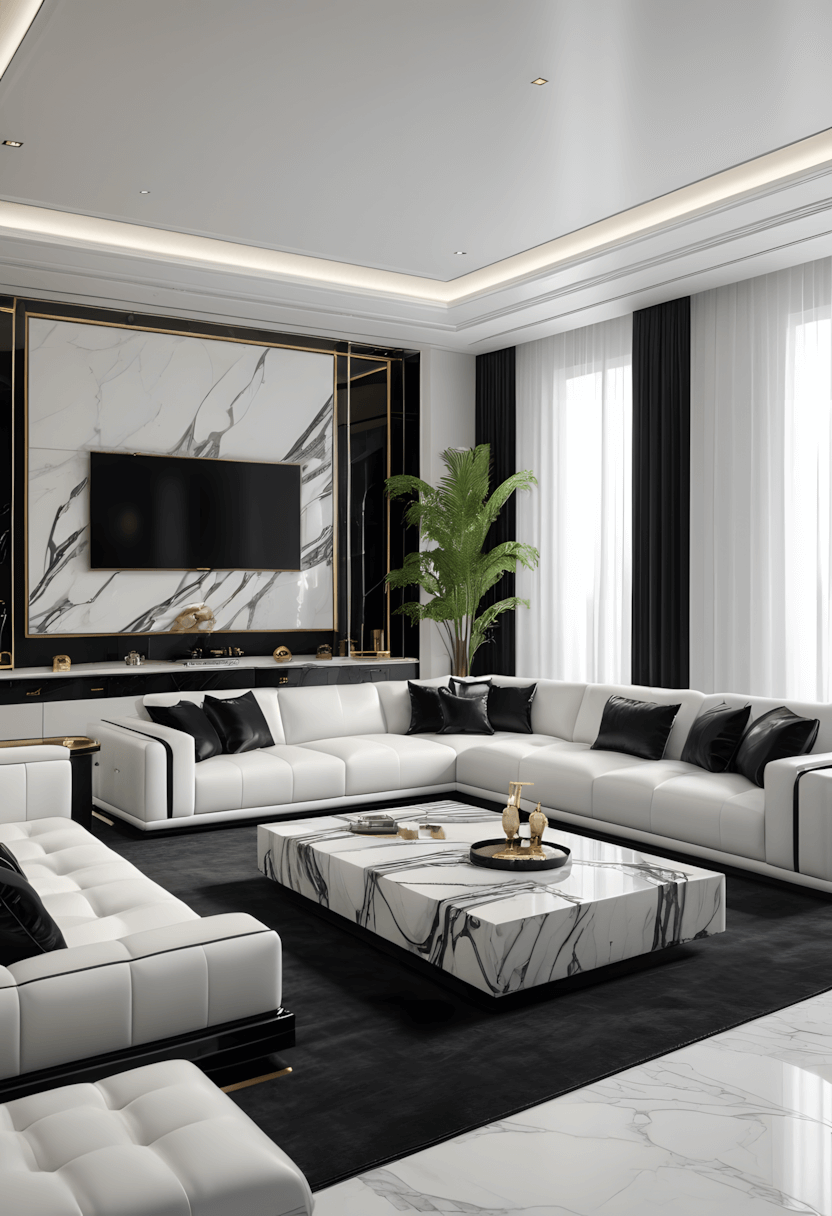
This refined approach often works well for homeowners wanting high-end appeal without excess. Quality materials in simple forms typically create environments that feel both luxurious and restrained.
Material investment: Fewer pieces often allow for higher-quality selections that provide lasting value and visual impact.
Design balance: Luxury elements often work best when they enhance rather than overwhelm the minimalist foundation.
11. Maximum Contrast
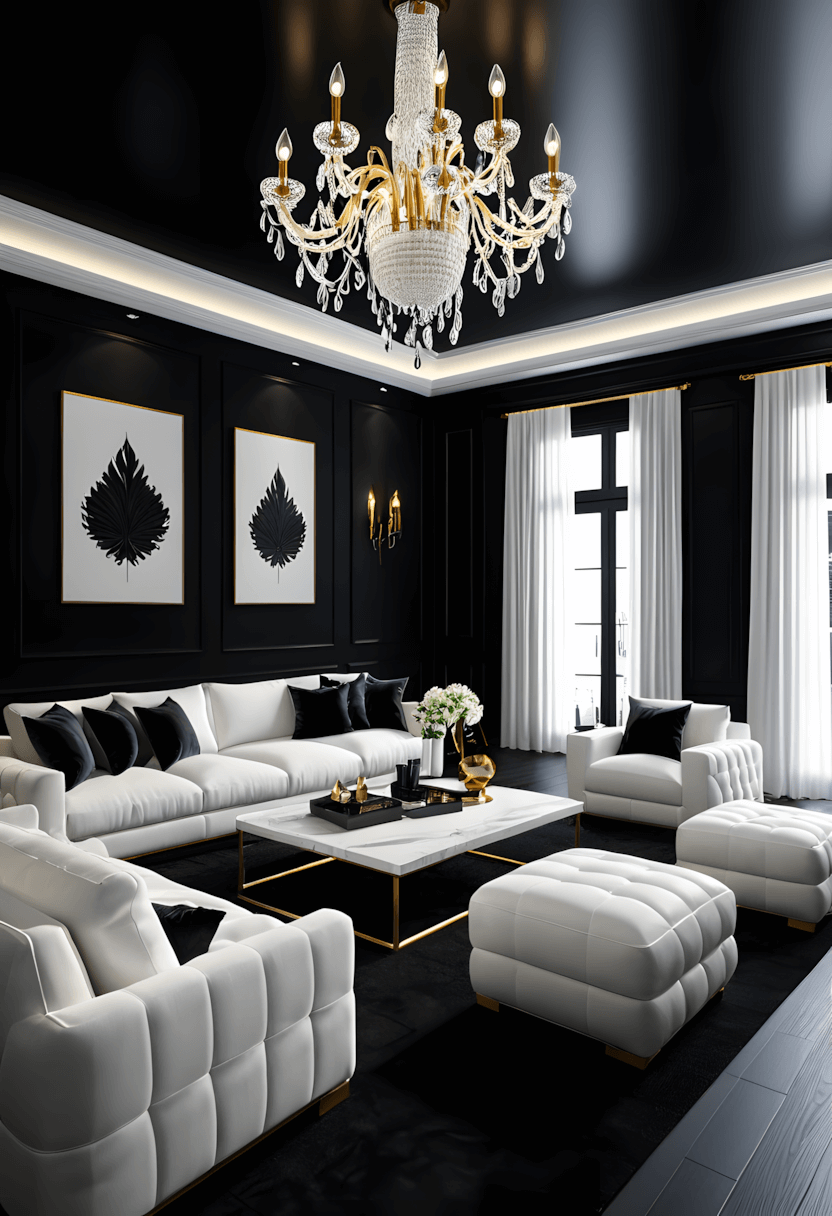
This dramatic approach often appeals to homeowners wanting bold, theatrical environments. Extreme contrasts between black and white typically create spaces that feel dynamic and visually exciting.
Design impact: Strong contrasts often make rooms feel more dramatic while requiring careful balance to remain livable.
Lighting consideration: Adequate lighting often becomes essential for making high-contrast schemes feel welcoming rather than stark.
12. Artistic Expression
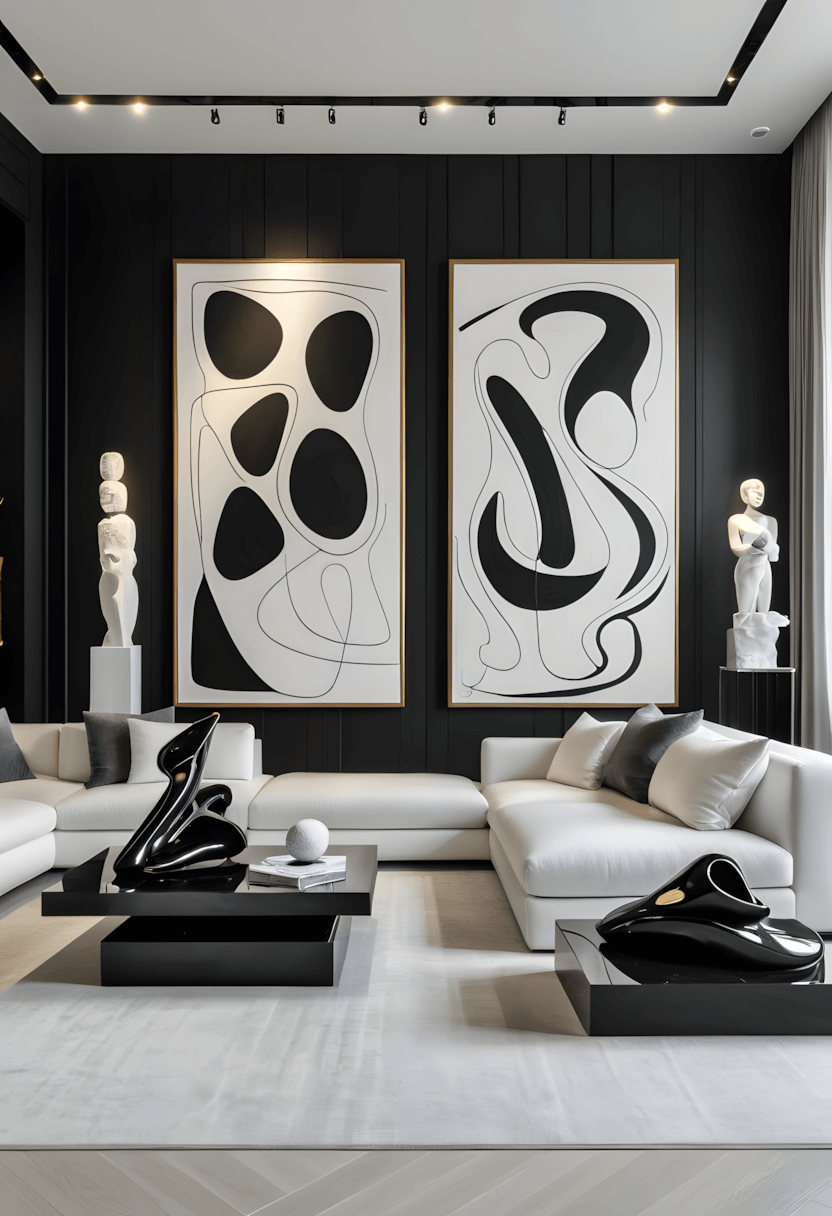
This creative approach often works well for homeowners who appreciate unique, gallery-like environments. Art-focused black and white spaces typically showcase creativity while maintaining sophisticated foundations.
Display strategy: Quality lighting and proper placement often become crucial for showcasing artwork effectively in monochrome settings.
Personal curation: This approach often allows for individual expression through carefully selected pieces that reflect personal taste.
13. Serene Monochrome
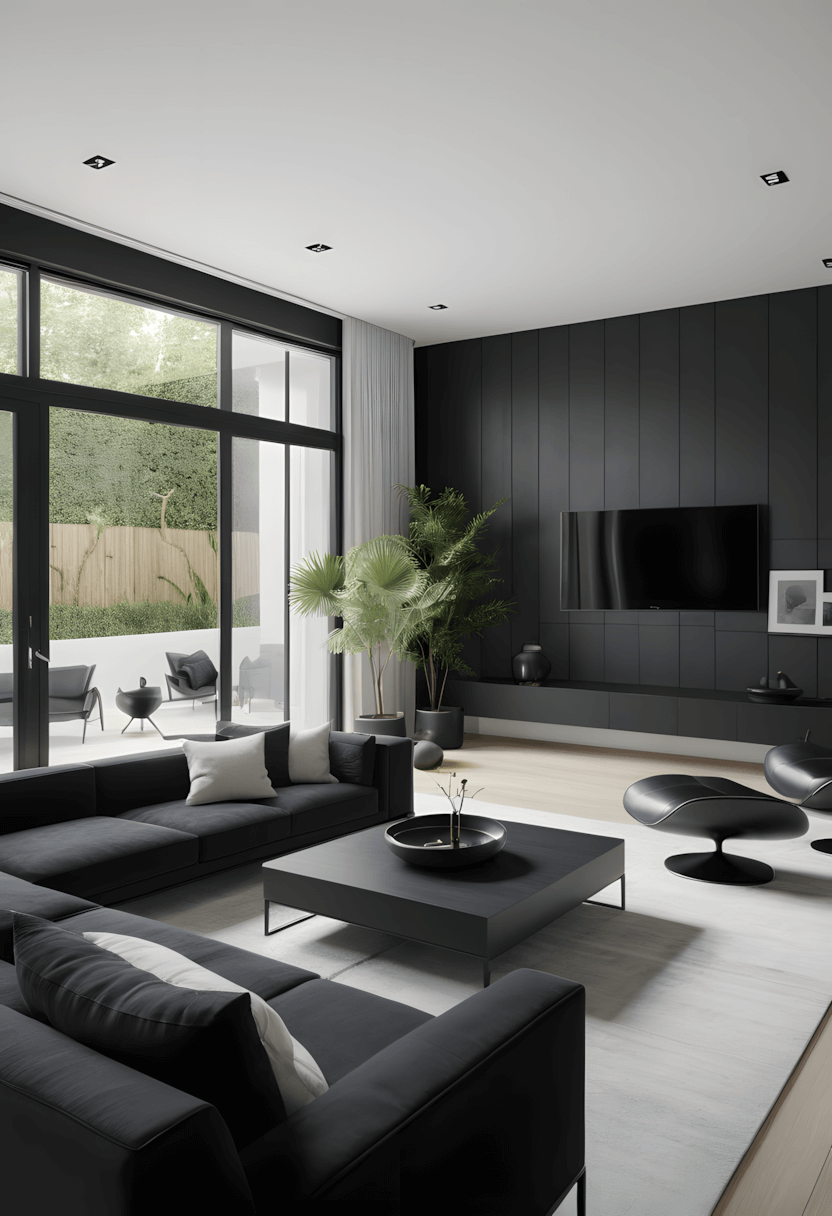
This calming approach often appeals to homeowners seeking peaceful, zen-like environments. Soft textures and gentle forms in black and white typically create tranquil spaces for relaxation.
Comfort focus: Emphasizing tactile comfort often helps monochrome spaces feel welcoming rather than cold or institutional.
Balance strategy: Mixing hard and soft elements often creates visual interest while maintaining the peaceful atmosphere.
14. Elegant Traditionalism
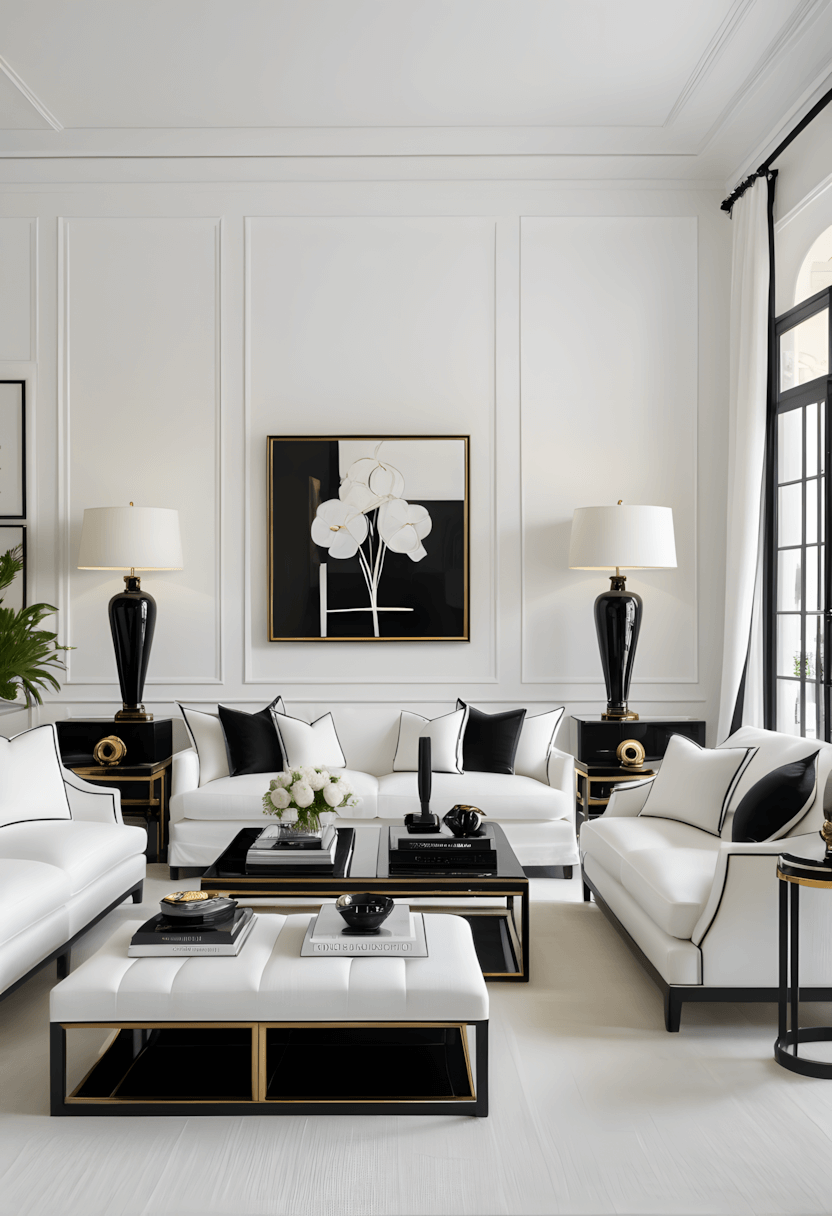
This refined approach often works well for homeowners appreciating classic sophistication with contemporary relevance. Traditional forms in black and white typically create timeless elegance.
Style integration: Blending traditional and modern elements often creates environments that feel both established and current.
Quality emphasis: Classic designs often require high-quality execution to achieve their intended sophisticated impact.
15. Tonal Gradation
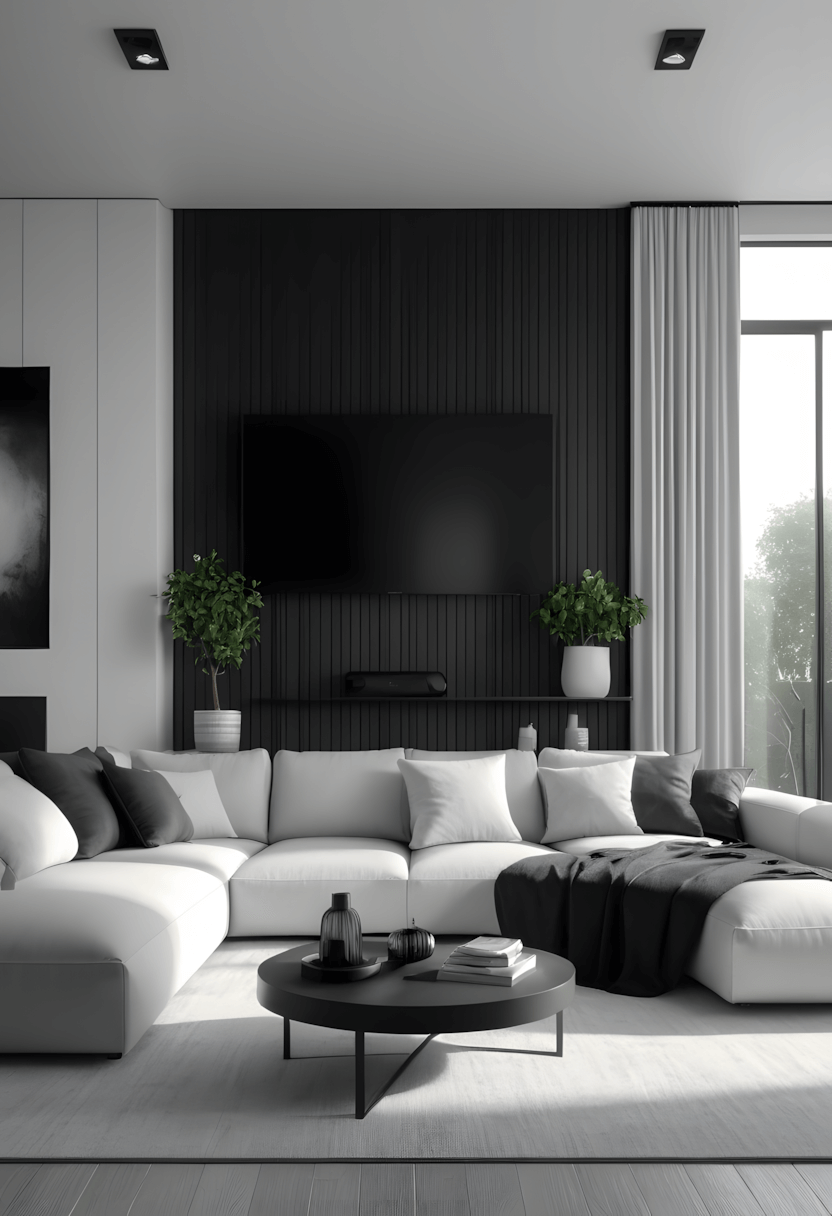
This nuanced approach often appeals to homeowners wanting sophistication without stark contrast. Varying shades of black, white, and gray typically create depth while maintaining monochrome harmony.
Color sophistication: Subtle tonal variations often provide visual interest without the dramatic impact of pure black-and-white contrast.
Design refinement: This approach often feels more sophisticated and professional than high-contrast alternatives.
16. Abstract Artistry
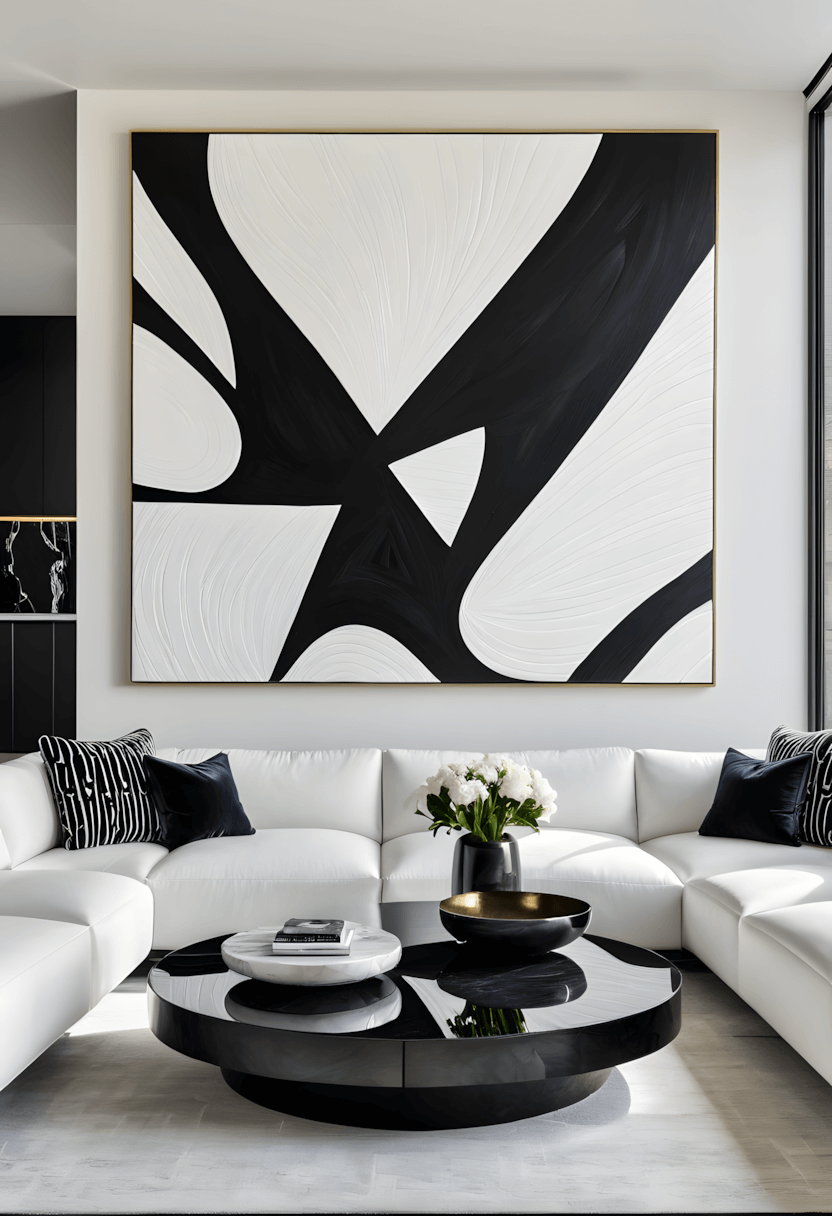
This creative approach often works well for homeowners wanting living spaces that feel like art galleries. Abstract elements in black and white typically create environments that stimulate creativity and conversation.
Artistic balance: Maintaining livability while showcasing artistic elements often requires careful planning and professional curation.
Personal statement: This approach often allows for significant individual expression while maintaining design sophistication.
17. Premium Monochrome
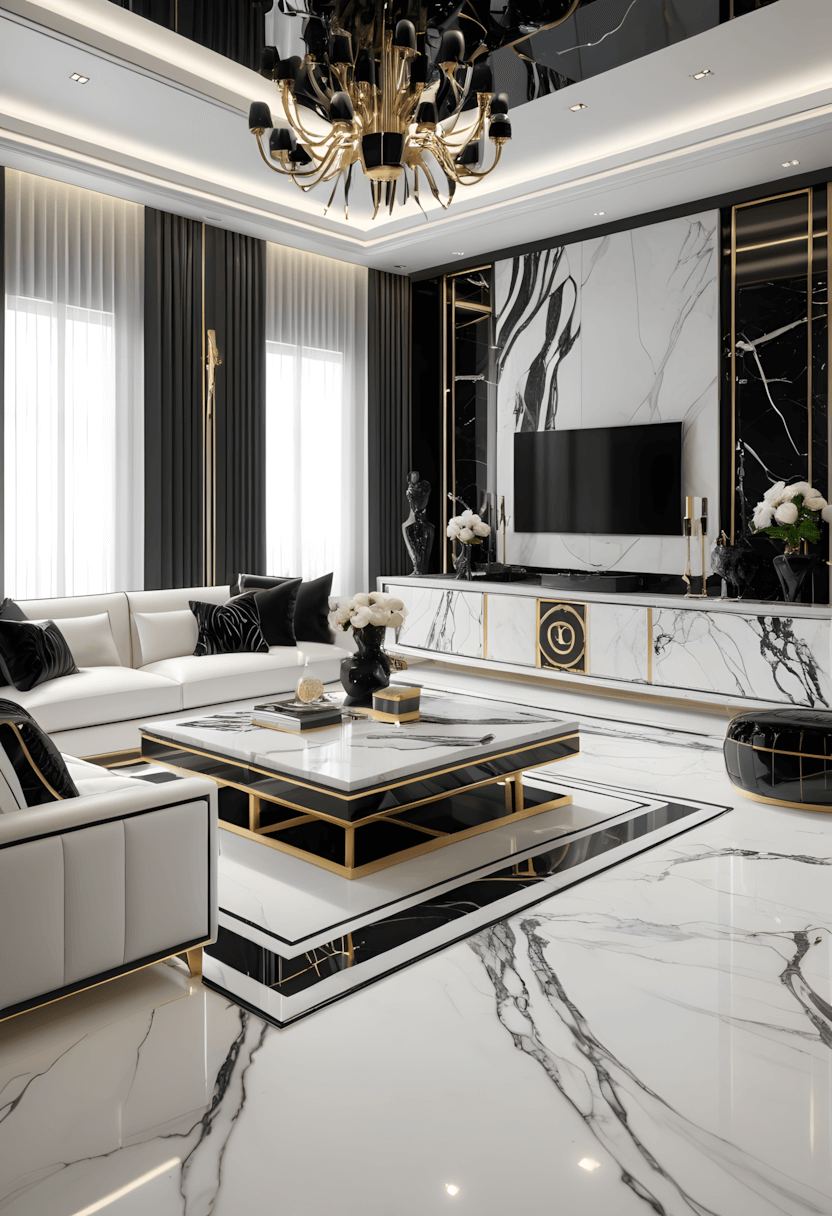
This luxurious approach often appeals to homeowners wanting high-end materials and finishes. Premium elements like marble, leather, and designer pieces typically create sophisticated, exclusive environments.
Investment strategy: Focusing on fewer, higher-quality pieces often provides better long-term value than numerous lesser items.
Design cohesion: Luxury materials often work together to create environments that feel intentionally designed and professionally curated.
18. Peaceful Simplicity
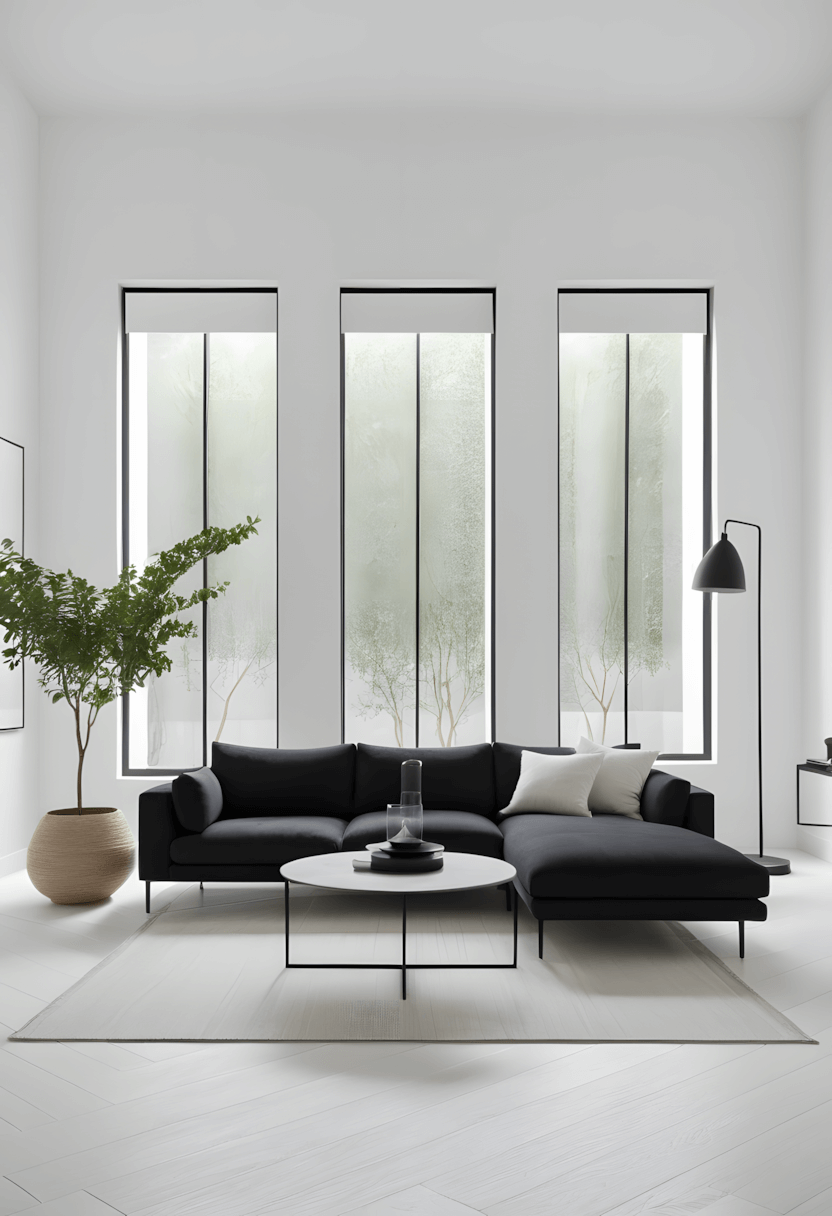
This calming approach often works well for homeowners prioritizing relaxation and stress reduction. Simple, uncluttered black and white spaces typically create environments that promote peace and well-being.
Psychological benefit: Simplified environments often reduce visual stress while providing calm foundations for daily life.
Maintenance advantage: Simpler designs often require less upkeep while maintaining their sophisticated appearance over time.
19. Textural Complexity
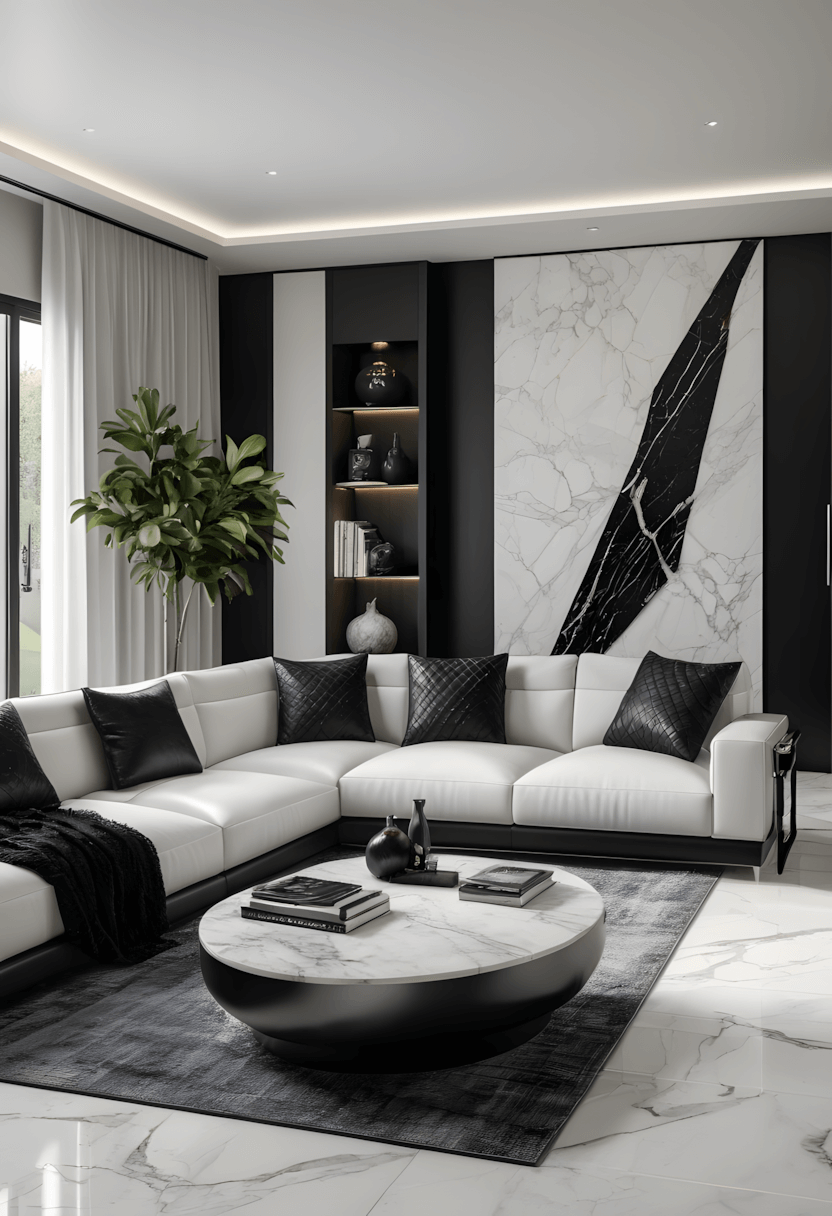
This layered approach often appeals to homeowners wanting visual and tactile interest. Multiple textures in black and white typically create rich, engaging environments without color complexity.
Sensory appeal: Varied textures often provide tactile interest that makes monochrome spaces feel more engaging and comfortable.
Design depth: Textural variety often prevents simple color schemes from appearing flat or monotonous.
20. Balanced Contrasts
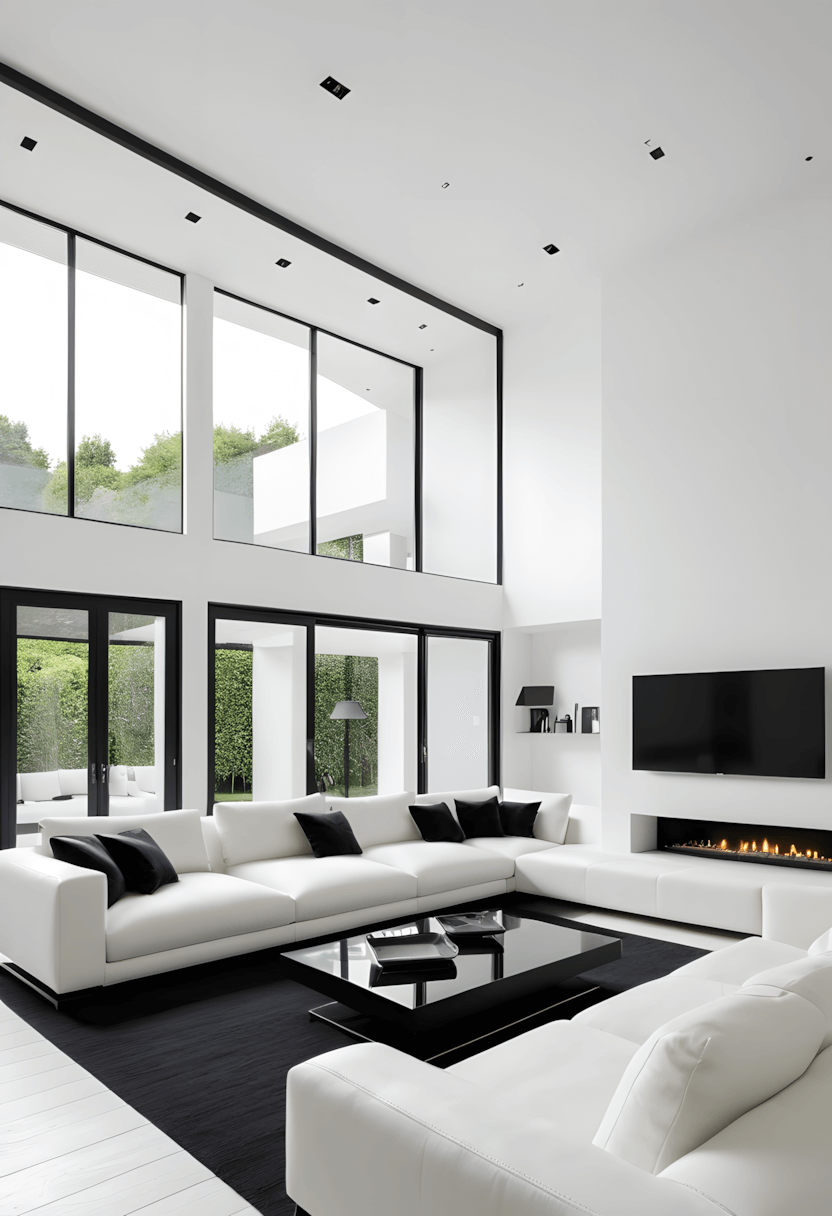
This harmonious approach often works well for homeowners wanting both comfort and visual interest. Balancing soft and hard elements typically creates environments that feel both stylish and livable.
Comfort integration: Combining structured elements with soft textures often creates spaces that work for both daily living and entertaining.
Visual harmony: Strategic balance often prevents any single element from overwhelming the overall design composition.
21. Glamorous Monochrome
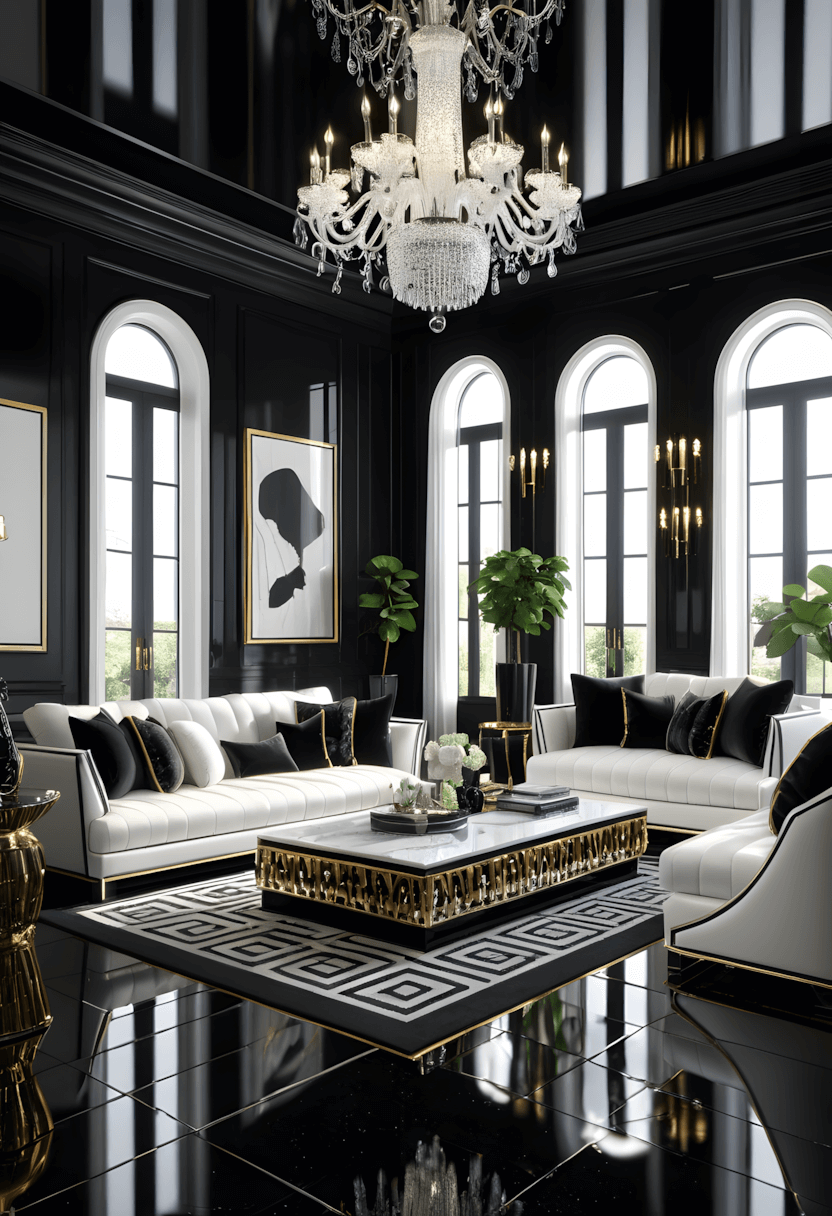
This sophisticated approach often appeals to homeowners wanting elegant, upscale environments. Glossy finishes and luxurious materials typically create spaces that feel both dramatic and refined.
Light interaction: Reflective surfaces often enhance lighting while creating dynamic visual effects throughout different times of day.
Luxury strategy: Strategic glamorous elements often provide high-end appeal without requiring complete room overhauls.
22. Refined Elegance
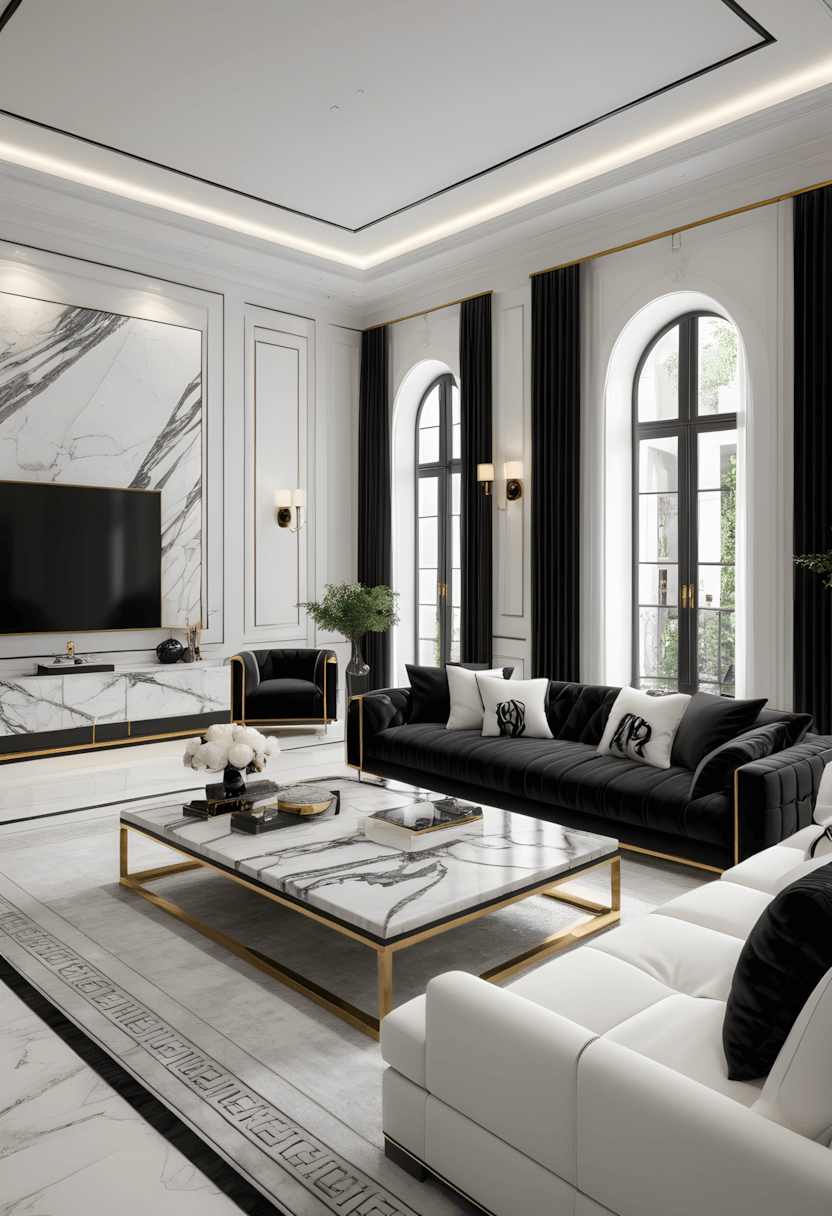
This polished approach often works well for homeowners appreciating understated sophistication. Carefully selected elements in black and white typically create environments that feel effortlessly elegant.
Design restraint: Quality over quantity often produces more sophisticated results than busy or overly decorated alternatives.
Timeless appeal: Refined elegance often transcends trends while maintaining relevance across changing style preferences.
23. Architectural Lines
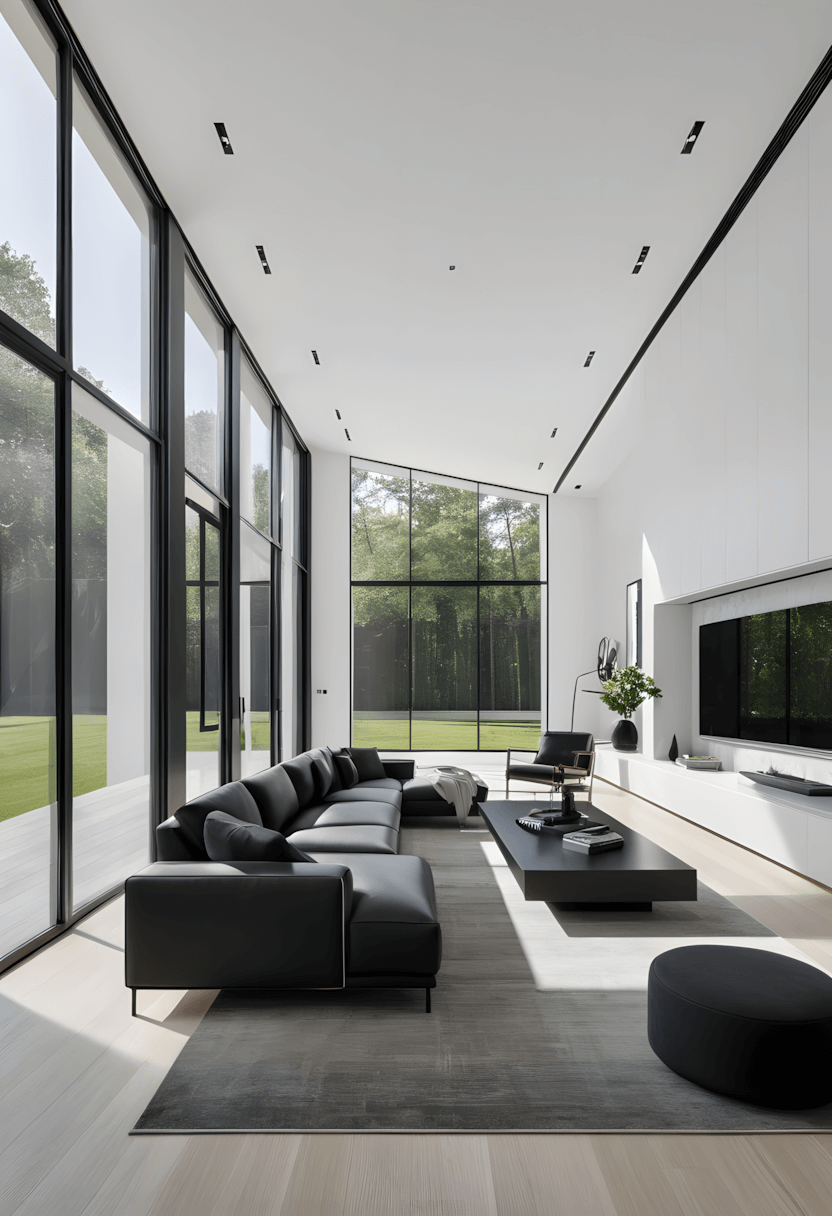
This structural approach often appeals to homeowners wanting clean, modern aesthetics. Emphasis on linear elements typically creates environments that feel organized and contemporary.
Design focus: Strong lines and geometric forms often provide visual structure that makes spaces feel intentionally designed.
Architectural enhancement: This approach often works particularly well in homes with interesting architectural features to highlight.
24. Understated Luxury
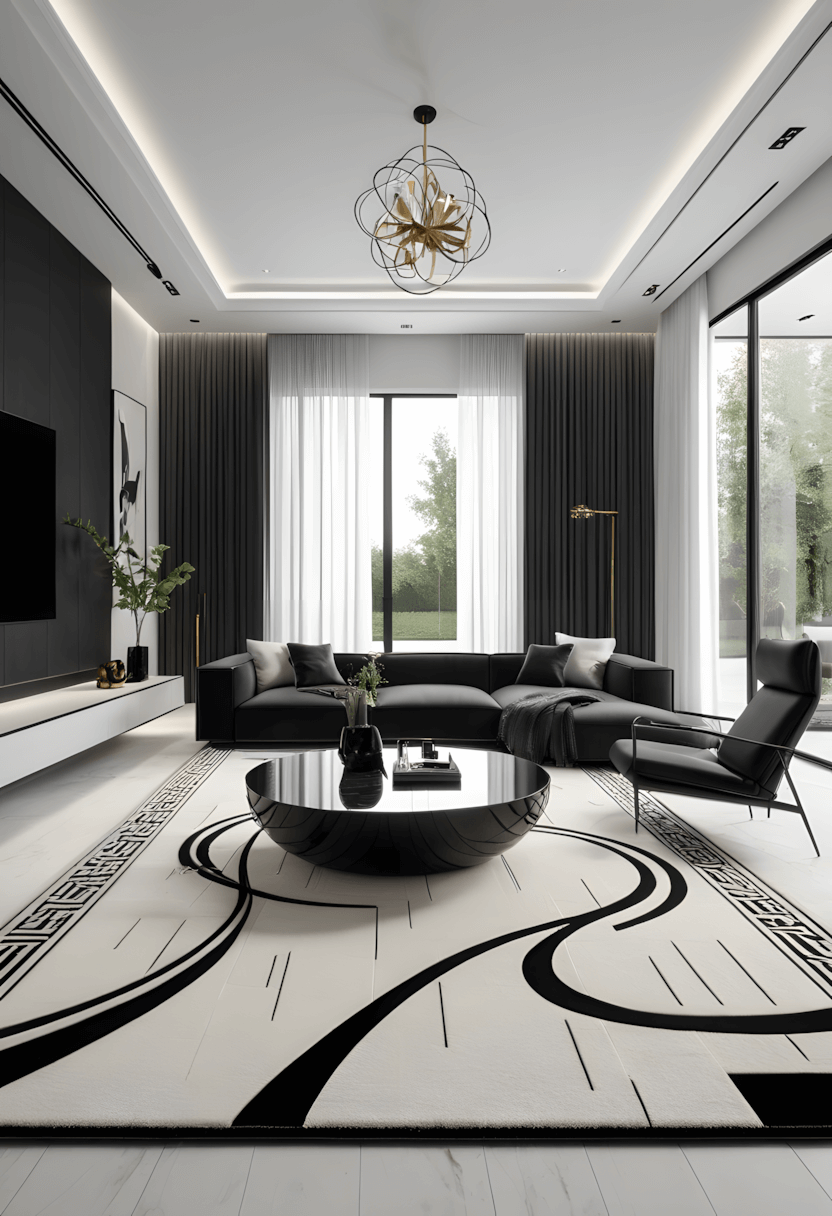
This sophisticated approach often works well for homeowners wanting high-end appeal without ostentation. Subtle luxury elements typically create environments that feel exclusive while remaining approachable.
Quality investment: Focusing on superior materials and craftsmanship often provides lasting luxury that improves with age.
Design sophistication: Understated approaches often demonstrate confidence and refined taste through restraint rather than excess.
25. Playful Monochrome
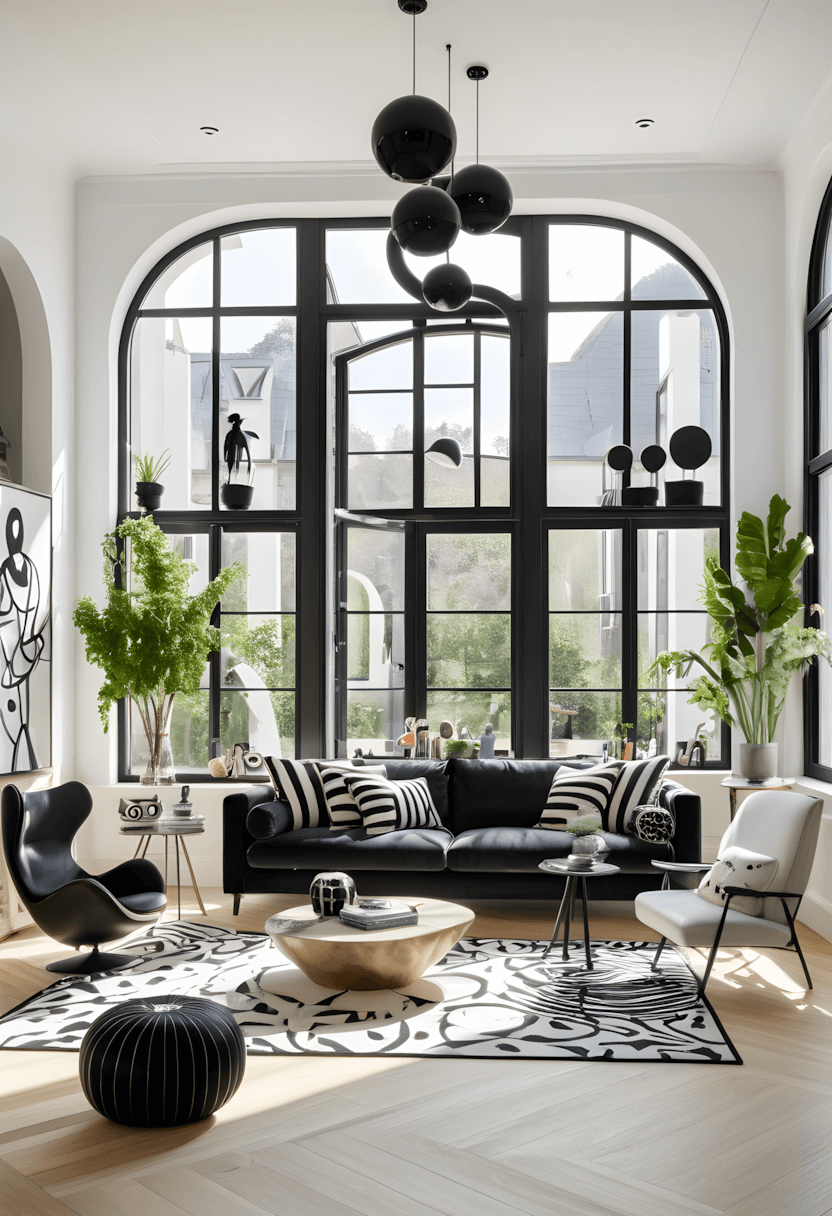
This creative approach often appeals to homeowners wanting personality within sophisticated frameworks. Whimsical elements in black and white typically add character while maintaining design coherence.
Personal expression: This approach often allows for individual creativity while staying within sophisticated design parameters.
Balance consideration: Playful elements often work best when balanced with more serious design foundations.
26. Surface Contrasts
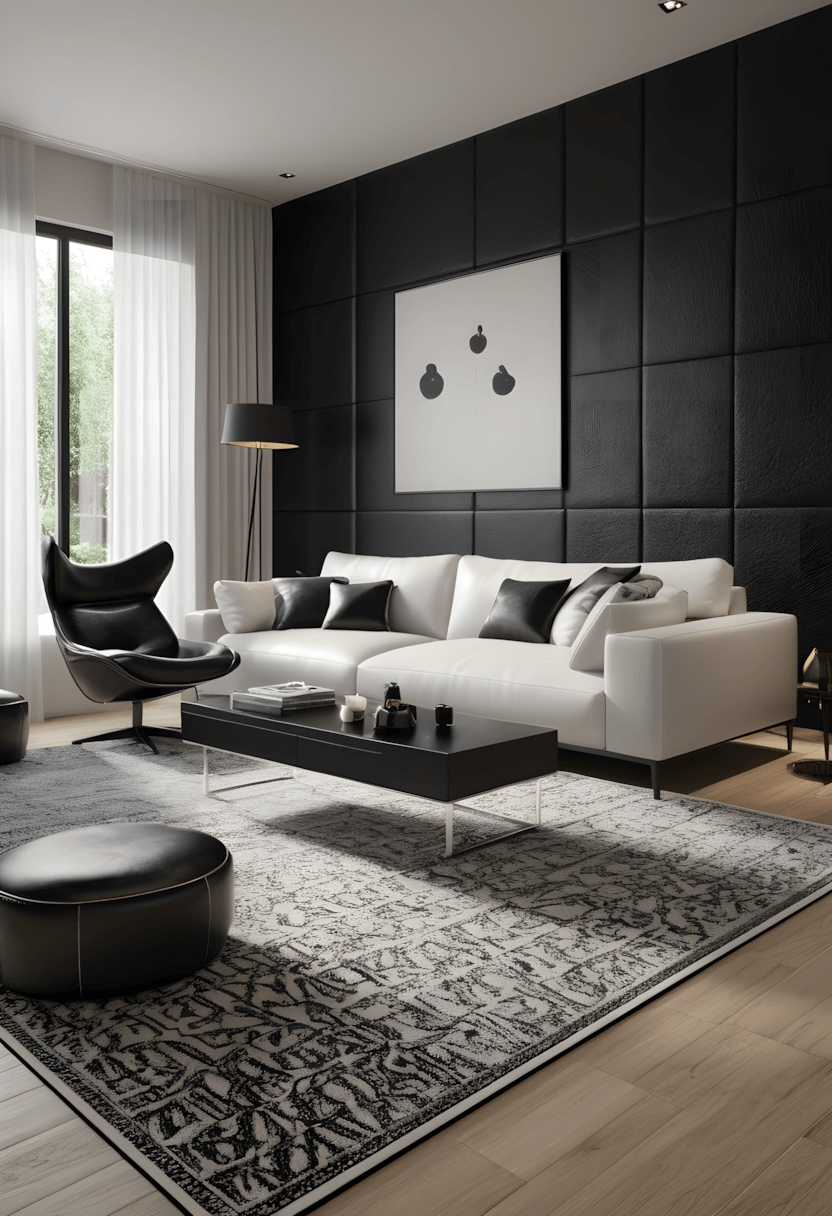
This textural approach often works well for homeowners appreciating tactile variety. Contrasting smooth and textured surfaces typically create visual interest while maintaining color simplicity.
Design technique: Surface variation often provides necessary visual complexity when working with limited color palettes.
Tactile appeal: Different surface treatments often make spaces more engaging and comfortable for daily use.
27. Dramatic Minimalism
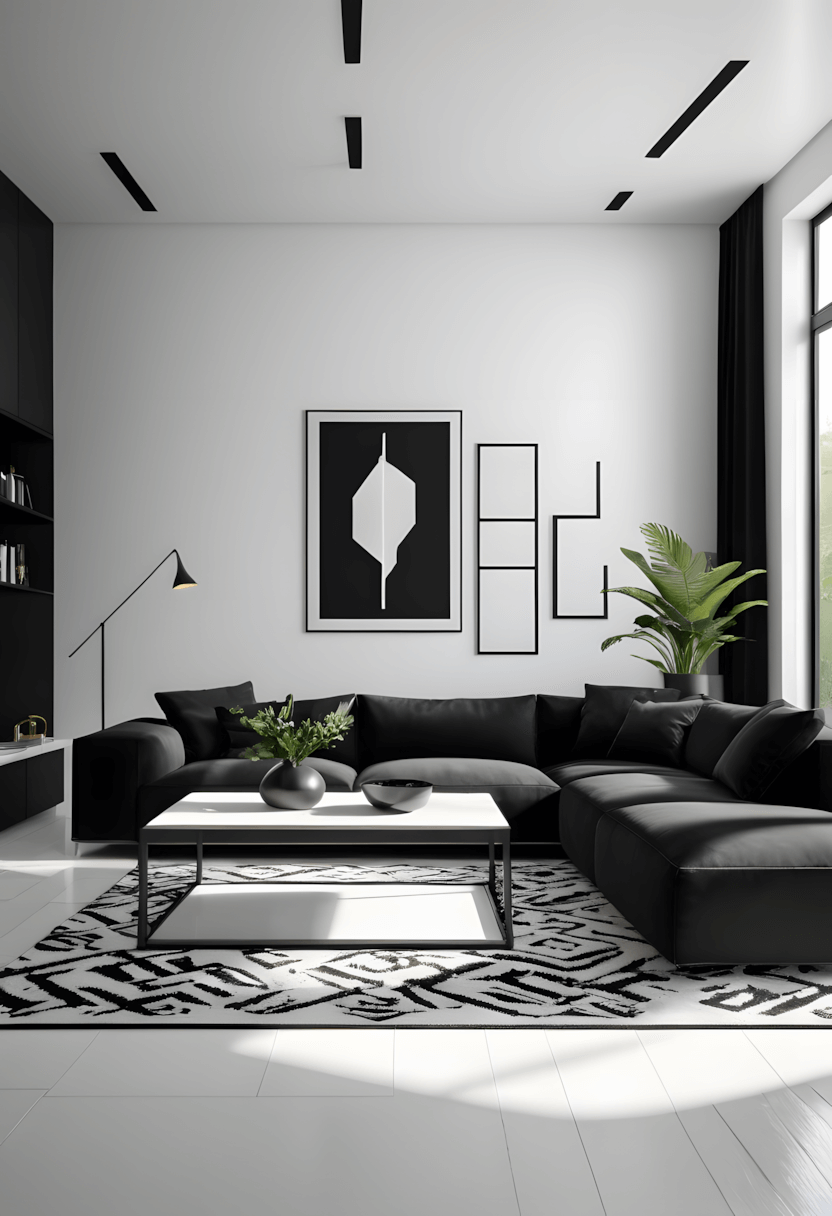
This bold approach often appeals to homeowners wanting maximum impact through minimal means. Strong contrast with sparse furnishing typically creates environments that feel both dramatic and serene.
Design confidence: This approach often requires confidence in selecting fewer, more impactful pieces rather than filling space with numerous items.
Visual impact: Strategic minimalism often creates more memorable impressions than busy or complex alternatives.
28. Simplified Drama
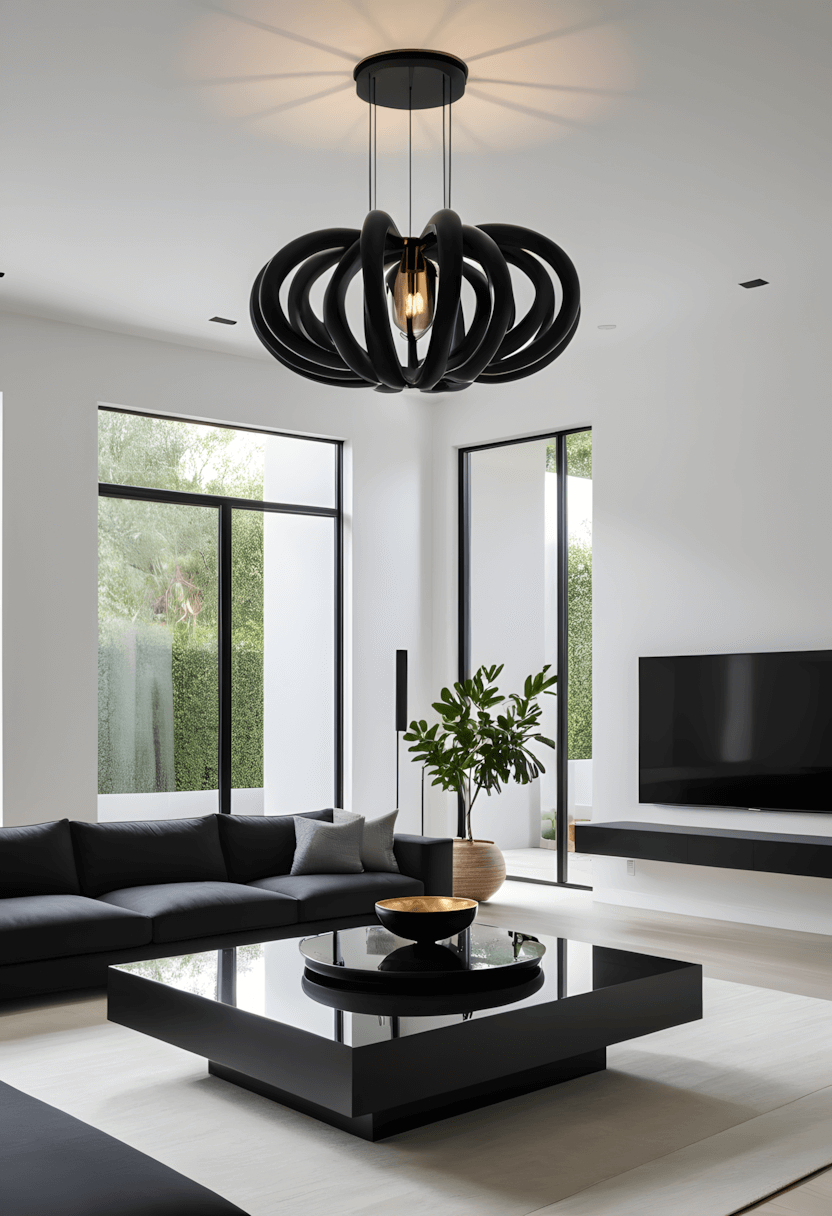
This focused approach often works well for homeowners wanting statement pieces without overwhelming complexity. Single dramatic elements typically anchor rooms while maintaining overall simplicity.
Focal strategy: One outstanding piece often provides more impact than multiple competing elements in minimalist settings.
Design clarity: Simplified approaches often create clearer, more memorable impressions than complex decorating schemes.
29. Comfortable Monochrome
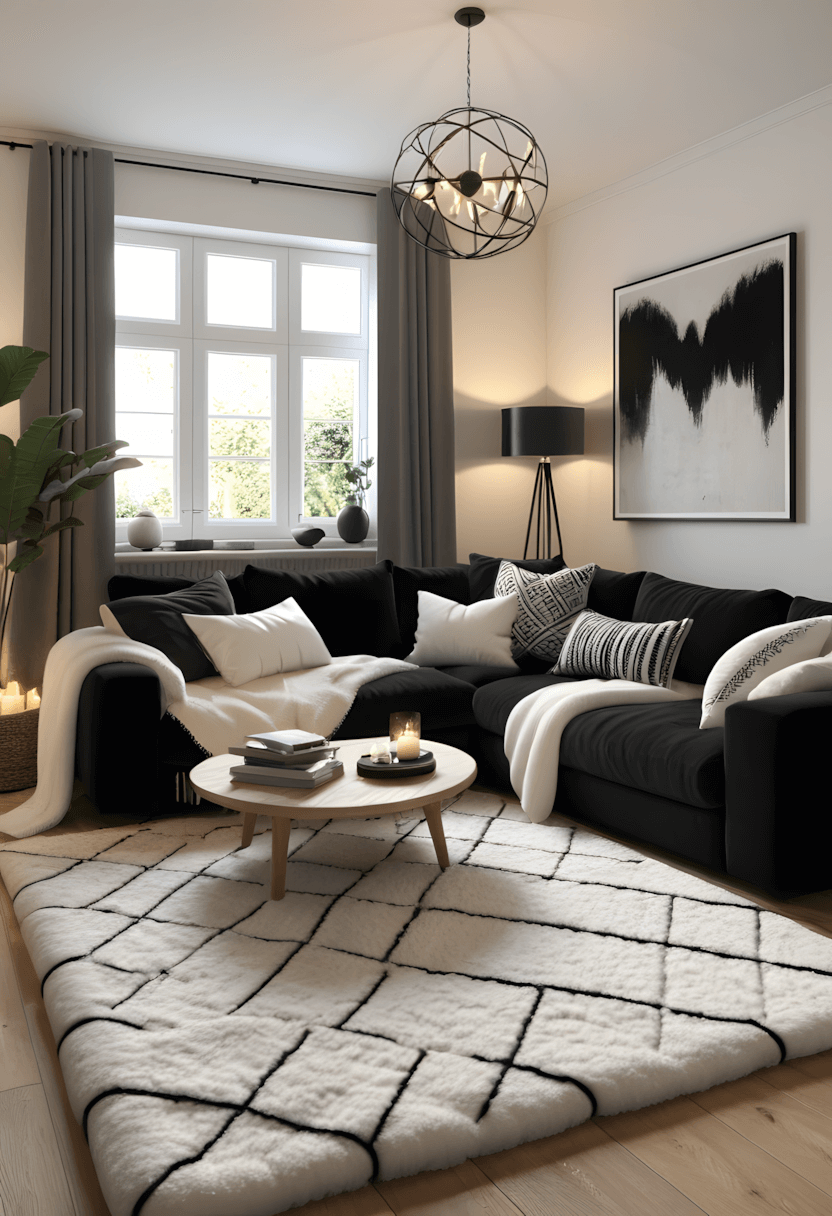
This welcoming approach often appeals to homeowners wanting sophisticated style without sacrificing comfort. Soft textures and cozy elements typically create spaces that feel both elegant and inviting.
Livability focus: Combining style with comfort often creates environments that work better for daily life and family activities.
Texture importance: Soft textiles often become crucial for making monochrome spaces feel warm and welcoming rather than cold.
Understanding Monochrome Balance
Through various projects, I’ve observed that successful black and white living rooms often depend on careful attention to proportion, texture, and lighting. The most effective monochrome spaces typically balance contrast with comfort while maintaining visual interest through varied materials and finishes rather than color complexity.
Lighting often becomes particularly important in black and white rooms, as proper illumination can make the difference between spaces that feel dramatic and sophisticated versus those that appear stark or unwelcoming.
Practical Implementation Strategies
Creating effective black and white living rooms often requires gradual layering of elements rather than complete room transformations. Starting with larger foundation pieces and adding textural elements often produces better results than attempting to achieve perfect monochrome schemes immediately.
Quality often matters more than quantity in monochrome design, as each element typically receives more visual attention when not competing with complex color schemes. This makes careful selection and placement particularly important for achieving desired aesthetic results.
Remember: For any electrical work, structural changes, or built-in installations mentioned in these ideas, always consult with licensed professionals to ensure proper installation and code compliance.

